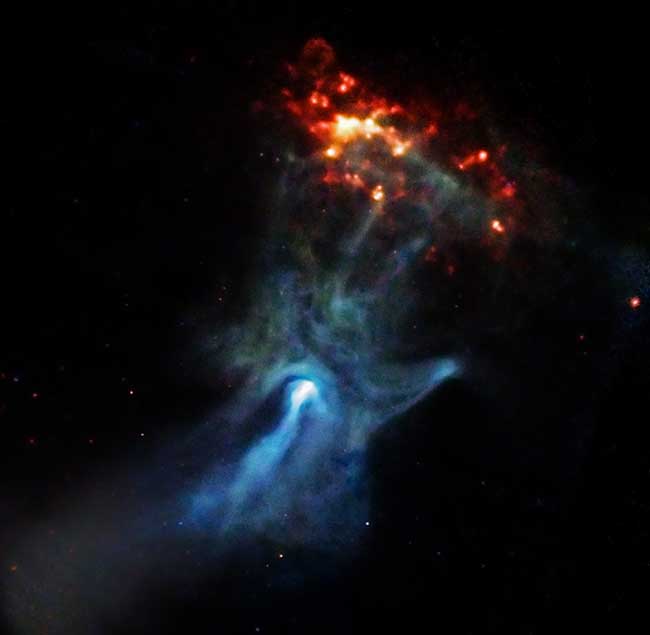|
4-30-09 - Sunspot number 1016 emerging - because of its
magnetics - it is a member of cycle 23.SUNSPOT
1016: A
ring-shaped sunspot numbered 1016 has emerged near
the sun's equator. Its magnetic polarity identifies it
as a member of old Solar Cycle 23. Until these old
cycle sunspots go away, the next solar cycle will
remain
in abeyance. Readers with solar telescopes should
point their optics
here.
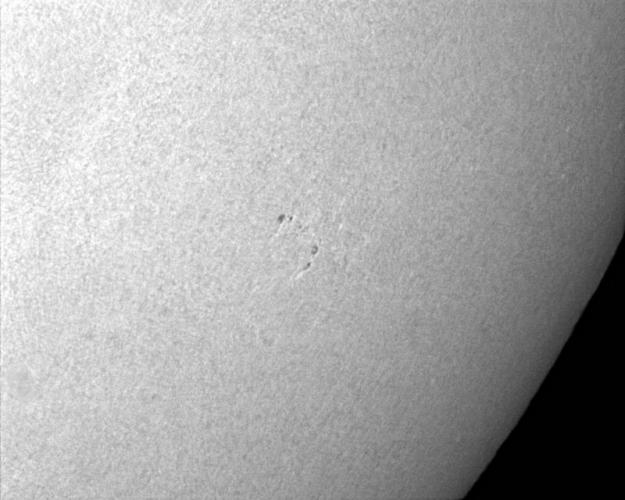
NOTE: I thought we had this same number sunspot
a month ago. If there is an error, it must be
mine.
Dee
SPACE WEATHER
Current conditions
Solar wind
speed: 325.4 km/sec
density: 3.7 protons/cm3
explanation |
more data
Updated: Today
at 2333 UT
X-ray Solar Flares
6-hr max: A2
2150 UT Apr30
24-hr: A6
1120 UT Apr30
explanation |
more data
Updated: Today
at: 2340 UT
The University of Western Australia's
new Zadko telescope has discovered a new asteroid - a 4
kilometer (2.5 mile) wide rock orbiting in the outer reaches of our
solar system. Curtin University Honors student, Mick Todd, used the
UWA facility to make the unexpected discovery while searching the sky
for potentially hazardous asteroids.
After checking the
major astronoimcal databases, it became clear that the Zadko Telescope
had imaged a new asteroid. Unlike comets, asteroids are numbered not
named. So instead of a Mick Todd asteroid, it will be known as
asteroid 2009 FH19.
In recent years, there has been a dramatic increase in the
number of rocks and asteroids being discovered because of
sophisticated telescopes. This data is contributing to a better
understanding of the solar system.
"In the next six months Mick plans to search for asteroids and rocks
lurking closer to Earth. Some of these are so close that impacts can
occur only hours after discovery," said Coward.
Such collaboration between UWA and Curtin has resulted in
students like Mick Todd making world class
discoveries, said Marjan Zadnik, a Curtin University professor.
|
4-29-09 - Sunspot 1016 from cycle 23 is emerging, but almost on the
edge of the sun as it goes around the back side.
Current conditions
Solar wind
speed: 351.5 km/sec
density: 1.6 protons/cm3
explanation |
more data
Updated: Today
at 2345 UT
X-ray Solar Flares
6-hr max: A0
2340 UT Apr29
24-hr: A0
0650 UT Apr29
explanation |
more data
Updated: Today
at: 2340 UT
SEVENTEEN MINUTES:
With a waistline one hundred times wider
than Earth's, the sun is so big and
ponderous, you might not think it could
move very quickly. But it can. Click on
the image to see how much things can
change in just 17 minutes:
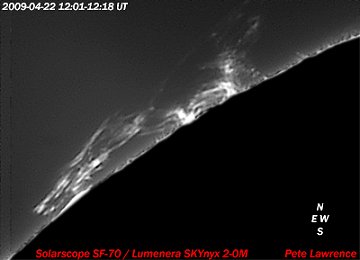
"A huge amount of motion
is visible over a very short interval of
time," says Pete Lawrence who made
the movie on April 22nd at his
backyard observatory in Selsey, UK. "The
prominence underwent many changes of form
and at one point I could see real time
movement as I watched the action on my
computer screen."
Less than 24 hours later,
Lawrence's prominence exploded and hurled
a billion-ton cloud of gas away from the
sun at nearly a million miles per hour:
SOHO movie. That's moving.
Readers, if you have a
solar telescope and 17 minutes of
spare time ... you know what to do.
|
|
4-28-09 Proto Sunspot trying to emerge. This sunspot's magnetics
tell us it's from cycle 23.

Current conditions
Solar wind
speed: 311.4 km/sec
density: 3.6 protons/cm3
explanation |
more data
Updated: Today
at 2345 UT
X-ray Solar Flares
6-hr max: A0
2340 UT Apr28
24-hr: A0
2340 UT Apr28
explanation |
more data
Updated: Today
at: 2340 UT
New Gamma-Ray Burst
Smashes Cosmic Distance Record
04.28.2009
April 28, 2009: NASA's Swift satellite and an
international team of astronomers have found a gamma-ray burst
from a star that died when the universe was only 630 million
years old--less than five percent of its present age. The
event, dubbed GRB 090423, is the most distant cosmic explosion
ever seen.
"The incredible distance to this burst exceeded our greatest
expectations -- it was a true blast from the past," says Swift
lead scientist Neil Gehrels at NASA's Goddard Space Flight
Center.
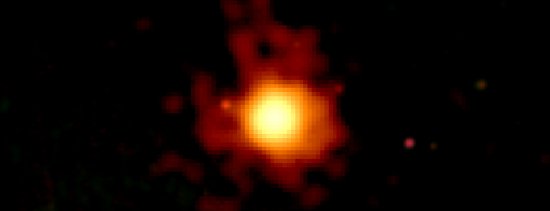
Above: GRB 090423 as seen by NASA's Swift
satellite. The image is a composite of data from Swift's
UV/Optical and X-Ray telescopes. Credit: NASA/Swift/Stefan
Immler [Larger
image]
The burst occurred at 3:55 a.m. EDT on April 23rd. Swift
quickly pinpointed the explosion, allowing telescopes on
Earth to target the burst before its afterglow faded away.
Astronomers working in Chile and the Canary Islands
independently measured the explosion's
redshift.
It was 8.2, smashing the previous record of 6.7 set by an
explosion in September 2008. A redshift of 8.2 corresponds
to a distance of 13.035 billion light years.
"We're seeing the demise of a star -- and probably the
birth of a black hole -- in one of the universe's earliest
stellar generations," says Derek Fox at Pennsylvania State
University.
Gamma-ray bursts are the most luminous explosions in the
Universe. Most occur when massive stars run out of nuclear
fuel. As their cores collapse into a black hole or neutron
star, jets of matter punch through the star and blast into
space. There, they strike gas previously shed by the star
and heat it, which generates short-lived afterglows in
many wavelengths.
For years, astronomers have been hunting for gamma-ray
bursts from the earliest generations of stars--and
mysteriously failing to find them. The detection of GRB
090423 is an important milestone in the quest to locate
bursts in the redshift range 10 to 20. More information: "The
Case of the Missing Gamma-ray Bursts."
Within three hours of the April 23rd burst,
Nial Tanvir at the University of Leicester,
U.K., and his colleagues reported detection of
an infrared source at the Swift position using
the United Kingdom Infrared Telescope on Mauna
Kea, Hawaii.
At the same time, Fox led an effort to obtain
infrared images of the afterglow using the
Gemini North Telescope on Mauna Kea. The
source appeared in longer-wavelength images
but was absent in an image taken at the
shortest wavelength of 1 micron. This "drop
out" corresponded to a distance of about 13
billion light-years.
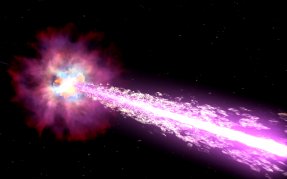
An artist's concept of a gamma-ray burst in
action.
Credit: NASA/Swift/Cruz deWilde.
As Fox spread the word about the record
distance, telescopes around the world turned
to observe the afterglow before it faded away.
At the Galileo National Telescope on La Palma
in the Canary Islands, a team including Guido
Chincarini at the University of Milan-Bicocca,
Italy, determined that the afterglow's
redshift was 8.2. Tanvir's team, gathering
nearly simultaneous observations using one of
the European Southern Observatory's Very Large
Telescopes on Cerro Paranal, Chile, arrived at
the same number.
"It's an incredible find," Chincarini says.
"What makes it even better is that a telescope
named for Galileo made this measurement during
the year in which we celebrate the 400th
anniversary of Galileo's first astronomical
use of the telescope."
|
4-27-09 - No sunspot today
Current conditions
Solar wind
speed: 378.5 km/sec
density: 3.2 protons/cm3
explanation |
more data
Updated: Today
at 2345 UT
X-ray Solar Flares
6-hr max: A0
2210 UT Apr27
24-hr: A0
2210 UT Apr27
explanation |
more data
Updated: Today
at: 2340 UT
ARIZONA
FIREBALL: Over the weekend,
midnight sky watchers in Arizona and New Mexico witnessed
a "spectacular fireball" that exploded in "a flash like
lightning." The brightness may have exceeded that of a
full Moon. The approximate time was 0604 UT, a few minutes
past midnight MDT on April 26th. A fireball camera
operated by Thomas Ashcraft near Santa Fe, NM, captured
the event, which was brilliant despite its low elevation:
Sonic Movie
1
:
ELF/VLF reception, 11 seconds. 500 KB
FBvlf20090426_0604UT_Ashcraft2.mp4
NOTE: the crackling sound and
tweeks are natural lightning emissions called
sferics. If you listen acutely there is a possible
enhancement of noise in sync with the flareup of the
meteor at 3 seconds into the movie. This enhancement
may be meteor related but it is difficult to say
conclusively.
Sonic Movie
2 : Forward scatter reception only at 61.250 MHz. 30
seconds, 1.1 MB
FBs61_20090426_0604ut_Ashcraft.mp4
Sonic Movie 3: 61.250 MHz and
ELF/VLF reception stereo, 30 seconds. 1.1 MB
FBvs61_20090426_0604UT_Ashcraft.mp435.50
|
4-26-09 - No sunspot today
Current conditions
Solar wind
speed: 375.2 km/sec
density: 2.0 protons/cm3
explanation |
more data
Updated: Today
at 2207 UT
X-ray Solar Flares
6-hr max: A0
2340 UT Apr26
24-hr: A0
2340 UT Apr26
explanation |
more data
Updated: Today
at: 2340 UT
|
4-25-09 No sunspot today
Current conditions
Solar wind
speed: 397.3 km/sec
density: 2.4 protons/cm3
explanation |
more data
Updated: Today
at 2347 UT
X-ray Solar Flares
6-hr max: A0
2340 UT Apr25
24-hr: A0
2340 UT Apr25
explanation |
more data
Updated: Today
at: 2340 UT
|
4-24-09 - No sunspot today
Current conditions
Solar wind
speed: 421.0 km/sec
density: 1.5 protons/cm3
explanation |
more data
Updated: Today
at 2345 UT
X-ray Solar Flares
6-hr max: A0
2325 UT Apr24
24-hr: A0
2325 UT Apr24
explanation |
more data
Updated: Today
at: 2340 UT
NOT-SO-QUIET SUN:
The sun produced an unexpected burst of
activity yesterday, April 23rd, when an
enormous prominence rose over the
northeastern limb and erupted. SOHO
recorded the blast from beginning to end
with a series of high-cadence UV
snapshots. Click on the image to set the
scene in motion:
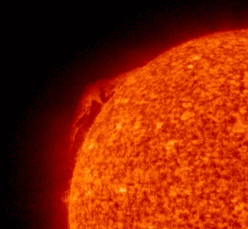
The complex
explosion produced not one but
two billion-ton coronal mass
ejections (CMEs):
movie. An impact from such
a double-CME would almost
surely spark magnetic storms
around the poles of Earth, but
it is not heading in our
direction. The chance of
auroras remains low.
VENUS AND THE
MOON:
On
April 22nd, Venus
and the Moon
converged for
close encounter of
rare beauty. "What
a spectacular
view!" says Marc
Provencher, who
woke up at dawn to
take this picture
of the pair rising
over Mt. Hood near
Portland, Oregon:
Minutes later, the
Moon passed
directly in front
of Venus,
producing a
crescent vs.
crescent eclipse.
Browse the links
below for some of
the best shots.
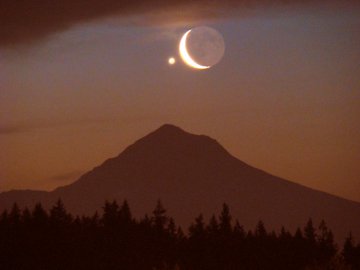
more
images:
from Adrian New
of Fort Davis,
Texas;
from Greg Stablein
of Memphis,
Tennessee;
from Val Ricks
of The Woodlands,
Texas;
from Paul Kinzer
of Galesville,
Wisconsin;
from Tom Polakis
of Tempe, Arizona;
from Peggy Collins
of Pacoima,
California;
from Bill Meyers
of Omaha,
Nebraska;
from Bret Dahl
of Plano, Texas;
from Antonio
Estrada of
Toluca, México;
a movie from John
McNair of
Monument,
Colorado;
from Mark Seibold
of Portland
Oregon;
|
4-23-09 No sunspot today
Current conditions
Solar wind
speed: 329.0 km/sec
density: 1.5 protons/cm3
explanation |
more data
Updated: Today
at 2345 UT
X-ray Solar Flares
6-hr max: A0
2340 UT Apr23
24-hr: A0
0040 UT Apr23
explanation |
more data
Updated: Today
at: 2340 UT
LYRID METEOR UPDATE:
Yesterday, April 22nd, Earth passed
through a stream of debris from Comet
Thatcher, and the encounter sparked the
annual Lyrid meteor shower. According to
the International Meteor Organization,
rates peaked at 16 meteors per
hour--not an intense display.
Nevertheless, a number of
pleasingly
bright
Lyrids were photographed by
spaceweather readers.
|
4-22-09 - Fading sunspot Current conditions
Solar wind
speed: 390.9 km/sec
density: 1.4 protons/cm3
explanation |
more data
Updated: Today
at 2345 UT
X-ray Solar Flares
6-hr max: A0
2340 UT Apr22
24-hr: A0
2340 UT Apr22
explanation |
more data
Updated: Today
at: 2340 UT
FADING SUNSPOT:
New sunspot 1015 emerged yesterday to
break a string of 25 consecutive spotless
days. It was a short break. Less than 24
hours after it appeared, the tiny sunspot
is already fading away.
SURGING
PROMINENCE: Every
clear day, astrophotographer
Pete Lawrence of Selsey, UK, scans the
limb of the sun for photogenic
prominences. "This morning I spotted a
rather odd looking one," he says. "I've
never seen anything quite like it before."
This photo shows the view through his
SolarScope SF-70:
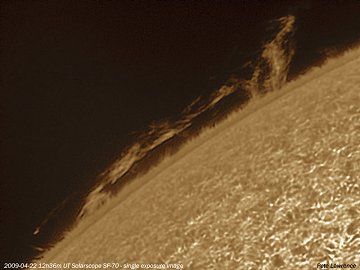
The twisting, swirling maelstrom
underwent
many changes in the hours that
followed Lawrence's first sighting. "At
one point I could see real time movement
on my computer screen," he says. "It was
amazing!"
Apparently, even the quiet sun has
something to offer. If you have a
solar telescope, take a look.
|
|
4-21-09 - New sunspot - They are calling this
sunspot 7 - assuming that means they started the count from the
beginning of cycle 24. NEW
SUNSPOT: Breaking a string of
25 consecutive spotless days, a new sunspot is forming
near the sun's northwestern limb. The magnetic
polarity of the spot identifies it as a member of new
Solar Cycle 24. Readers, if you have a
solar telescope, now is the time to watch sunspot
genesis in action. images:
from Pete Lawrence of Selsey, West Sussex, UK;
Details::
Really
poor sky conditions prevented me using
much in the way of magnification today but
a low power mosaic shows some of the
interesting regions of activity which seem
to be trying to break through close to the
western limb at the moment. Perhaps it's
time for the Sun to wake up at last?!
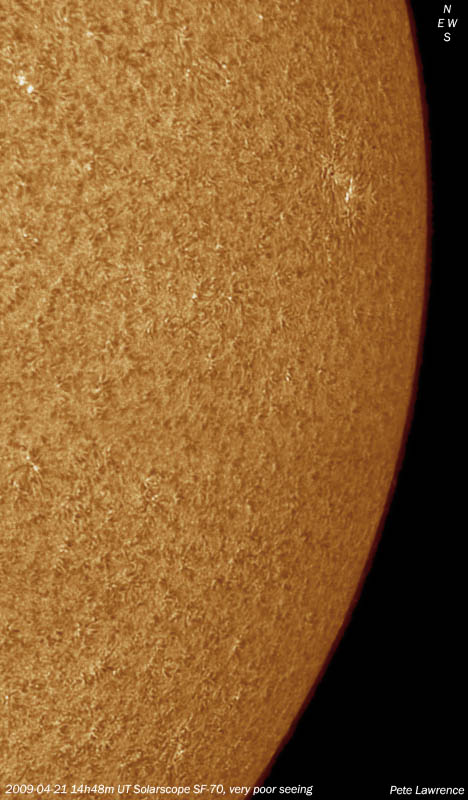
from Jan Timmermans of Valkenswaard, The
Netherlands
Current conditions
Solar wind
speed: 415.8 km/sec
density: 0.7 protons/cm3
explanation |
more data
Updated: Today
at 2346 UT
X-ray Solar Flares
6-hr max: A0
2340 UT Apr21
24-hr: A0
2340 UT Apr21
explanation |
more data
Updated: Today
at: 2340 UT
|
4-20-09 - No sunspots today - There are no dark coronal holes either.
- The sun is really blank
Current conditions
Solar wind
speed: 456.4 km/sec
density: 2.0 protons/cm3
explanation |
more
data
Updated: Today at 2306
UT
X-ray Solar Flares
6-hr max: A0 2300
UT Apr20
24-hr: A0 2300 UT
Apr20
explanation |
more data
Updated: Today at: 2300
UT
MORNING
METEORS: Earth is entering a stream
of dusty debris from Comet Thatcher, source of the annual
Lyrid meteor shower. Forecasters expect the shower to peak
during the dark hours before dawn on Wednesday, April
22nd, when observers should count 10 to 20 meteors per
hour:
more information.
Got clouds? No problem. If you can't see the shower,
you can listen to it on
Space Weather Radio.
We are streaming live signals from the Air Force Space
Surveillance Radar in Texas. Whenever a meteor passes
overhead--ping!--there is an echo. The Lyrids should
produce a surge of activity on April 22nd.
On April 2nd, ham radio operator Stan Nelson of
Roswell, New Mexico, was listening to the radar's signals
when the International Space Station and a meteor
passed through the beam in quick succession. Click on the
dynamic spectrum to listen:
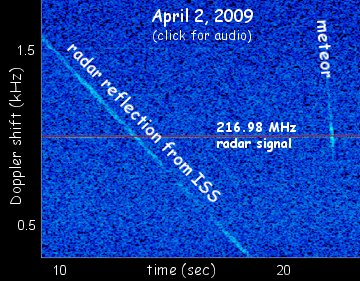
audio:
with noise reduction |
w/o noise reduction
The slowly descending tone at the
beginning of the soundtrack is the radar's doppler-shifted
reflection from the ISS. It sounds like the whistle of a
train racing past a stationary bystander. Indeed, the
basic
physics of the doppler shift is the same in both
cases.
The rapidly descending tone near the end
of the soundtrack is the radar's doppler-shifted
reflection from a meteor. Because meteors travel through
space some two to ten times faster than Earth-orbiting
spacecraft, their radar reflections are much more sharply
doppler shifted.
On April 22nd you might hear both kinds of
reflections as Lyrid meteors and various Earth-orbiting
satellites pass over the radar facility.
Tune in!
|
4-19-09 - No sunspots today
Current conditions
Solar wind
speed: 434.6 km/sec
density: 0.7 protons/cm3
explanation |
more data
Updated: Today
at 2345 UT
X-ray Solar Flares
6-hr max: A0
2340 UT Apr19
24-hr: A0
2340 UT Apr19
explanation |
more data
Updated: Today
at: 2340 UT
|
4-18-09 - No sunspots today
Current conditions
Solar wind
speed: 491.4 km/sec
density: 0.5 protons/cm3
explanation |
more data
Updated: Today
at 2343 UT
X-ray Solar Flares
6-hr max: A0
1625 UT Apr18
24-hr: A1
0310 UT Apr18
explanation |
more data
Updated: Today
at: 2340 UT
EXPLOSION
ON THE SUN:
THIS IS WHAT WE WORRY ABOUT FOR
THE FUTURE WHEN IT'S DIRECTED AT EARTH:
A billion-ton cloud of hot
magnetized gas has just left the sun. The Solar and
Heliospheric Observatory (SOHO) recorded the explosion
at the end of the day on April 17th:
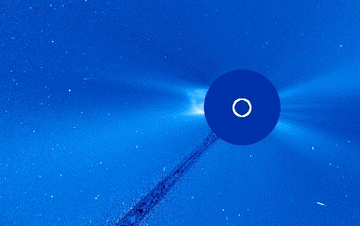
The bright coronal mass ejection (CME) is not
heading for Earth, so there will be no geomagnetic
effects from the explosion. But it does remind us that
sunspots are not required for solar activity. The
source of the blast appears to be
an erupting prominence high above the sun's
northeastern limb.
The sun may be blank, but it is not quiet.
Monitoring is encouraged.
more images:
from Alan Friedman of Buffalo, New York;
from Leslie Marczi of Welland, Ontario, Canada;
from James Kevin Ty of Manila, the Philippines;
from Fabio Acquarone of Caramagna, Liguria, Italy;
from Michael Buxton of Ocean Beach, California;
|
4-17-09 - No sunspots today
Current conditions
Solar wind
speed: 454.3 km/sec
density: 1.8 protons/cm3
explanation |
more data
Updated: Today
at 2343 UT
X-ray Solar Flares
6-hr max: A0
2340 UT Apr17
24-hr: A0
2340 UT Apr17
explanation |
more data
Updated: Today
at: 2340 UT <
|
4-16-09 - No sunspots today
Current conditions
Solar wind
speed: 401.0 km/sec
density: 5.1 protons/cm3
explanation |
more data
Updated: Today
at 2345 UT
X-ray Solar Flares
6-hr max: A0
2340 UT Apr16
24-hr: A0
2340 UT Apr16
explanation |
more data
Updated: Today
at: 2340 UT
|
4-15-09 No sunspots today
Current conditions
Solar wind
speed: 304.7 km/sec
density: 2.2 protons/cm3
explanation |
more data
Updated: Today
at 2345 UT
X-ray Solar Flares
6-hr max: A0
2340 UT Apr15
24-hr: A0
2340 UT Apr15
explanation |
more data
Updated: Today
at: 2340 UT
SLOW-MOTION EXPLOSIONS: How
deep is
solar minimum? Consider this: The most powerful
solar explosions are now moving in slow motion.
"Lately, coronal mass ejections (CMEs) have become
very slow, so slow that they have to be dragged away
from the sun by the solar wind," says researcher
Angelos Vourlidas of the Naval Research Lab. Here is
an example from April 11th:
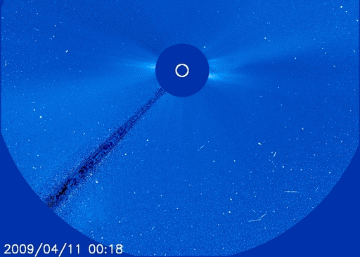
Each second in the SOHO animation corresponds to an
hour or more of real time. "The speed of the CME was
only 240 km/s," says Vourlidas. "The solar wind speed
is about 300 km/s, so the CME is actually being
dragged."
Vourlidas has examined thousands of CMEs recorded
by SOHO over the past 13 years, and he's rarely seen
such plodding explosions. In active times, CMEs can
blast away from the sun faster than 1000 km/s. Even
during the solar minimum of 1996, CMEs often revved up
to 500 or 600 km/s. "Almost all the CMEs we've seen
since the end of April 2008, however, are very slow,
less than 300 km/s."
Is this just another way of saying "the sun is very
quiet?" Or do slow-motion CMEs represent a new and
interesting phenomena? The jury is still out. One
thing is clear: solar minimum is more interesting than
we thought.
|
4-14-09 - No sunspots today
Current conditions
Solar wind
speed: 340.9 km/sec
density: 0.8 protons/cm3
explanation |
more data
Updated: Today
at 2345 UT
X-ray Solar Flares
6-hr max: A0
2220 UT Apr14
24-hr: A0
2220 UT Apr14
explanation |
more data
Updated: Today
at: 2340 UT
Spotless Days
Current Stretch: 19 days
2009 total: 91 days (88%)
Since 2004: 602 days
Typical Solar Min: 485 days
explanation |
more info
Updated 14 Apr 2009
The Surprising Shape of Solar Storms |
|
April 14, 2009: This just in: The Sun
is blasting the solar system with croissants.
Researchers studying data from NASA's twin STEREO
probes have found that ferocious solar storms called
CMEs (coronal mass ejections) are shaped like a French
pastry. The elegance and simplicity of the new
"croissant model" is expected to dramatically improve
forecasts of severe space weather.
"We believe we can now predict when a CME will hit
Earth with only 3-hours of uncertainty," says Angelos
Vourlidas of the Naval Research Lab, who helped
develop the model. "That's a four-fold improvement
over older methods."
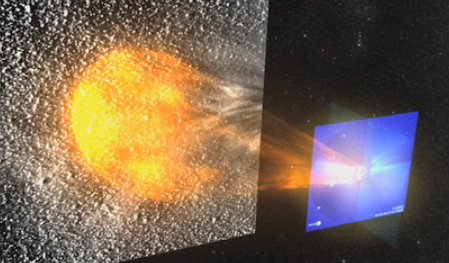
Above: An artist's
concept of a croissant-shaped CME. Click
on the image to launch
a movie of the explosion. Credit: NASA
Coronal mass ejections are billion-ton
clouds of hot magnetized gas that explode
away from the sun at speeds topping a
million mph. Sometimes the clouds make a
beeline for Earth and when they hit they
can cause geomagnetic storms, satellite
outages, auroras, and power blackouts. The
ability to predict the speed and
trajectory of a CME is key to space
weather forecasting.
"This is an important advance," says Lika
Guhathakurta, STEREO program scientist at
NASA headquarters in Washington DC. "From
a distance, CMEs appear to be a
complicated and varied population. What we
have discovered is that they are not so
varied after all. Almost all of the
40-plus CMEs we have studied so far with
STEREO have a common shape--akin to a
croissant."
Thousands of CMEs have been observed by
NASA and European Space Agency spacecraft,
but until now their common shape was
unknown. That's because in the past
observations were made from only a single
point of view. The STEREO mission has the
advantage of numbers. It consists of two
probes that flank the sun and photograph
explosions from opposite sides. STEREO's
sensitive wide-field cameras can track
CMEs over a wider area of sky than any
other spacecraft, following the progress
of the storm all the way from the sun to
the orbit of Earth.
"STEREO has done what no previous mission
could," notes Guhathakurta.
Vourlidas says he is not surprised that
CMEs resemble French pastries. "I have
suspected this all along. The croissant
shape is a natural result of twisted
magnetic fields on the sun and is
predicted by a majority of theoretical
models."
He offers the following analogy: Take a
length of rope and hold one end in each
hand. Start twisting the ends in opposite
directions. Twist, twist and continue
twisting until the middle of the rope is a
fat knotted mess.
 "That's
how CMEs get started—as twisted ropes of
solar magnetism. When the energy in the
twist reaches some threshold, there is an
explosion which expels the CME away from
the sun. It looks like a croissant because
the twisted ropes are fat in the middle
and thin on the ends." "That's
how CMEs get started—as twisted ropes of
solar magnetism. When the energy in the
twist reaches some threshold, there is an
explosion which expels the CME away from
the sun. It looks like a croissant because
the twisted ropes are fat in the middle
and thin on the ends."
Right: A computer model
of a croissant-shaped CME. Models like
this can be rapidly fit to real CMEs as
soon as they are observed, allowing
forecasters to accurately estimate the
speed and trajectory of the storms:
movie. Credit: NASA.
The shape alone, however, does not tell
the full story of a CME. The contents of
the CME must be considered, too. How much
plasma does it contain? What is the
orientation and strength of its internal
magnetic field? When a CME strikes, the
havoc it causes will depend on the
answers—answers the croissant model does
not yet provide.
"There is more work to do. We must learn
to look at a CME and not only trace its
shape, but also inventory in contents,"
says Guhathakurta. "We are halfway there."
Eventually, the quest to learn what lies
inside the croissant will be taken up by
other spacecraft such as the Solar
Dynamics Observatory, slated to launch in
August 2009, and Solar Probe+, a daring
mission (still on the drawing board) to
fly close to the sun and actually enter
these storms near their source.
STEREO isn't finished, though. The two
probes are continuing their journeys to
opposite sides of the sun for a 24/7,
360-degree view of the star. Along the
way, they'll actually run into a few CMEs
and have the chance to sample the
'croissants' in situ.
Author:
Dr. Tony Phillips | Credit:
Science@NASA
|
4-13-09 - No sunspots today
Current conditions
Solar wind
speed: 369.1 km/sec
density: 2.2 protons/cm3
explanation |
more data
Updated: Today
at 2345 UT
X-ray Solar Flares
6-hr max: A0
2340 UT Apr13
24-hr: A0
1315 UT Apr13
explanation |
more data
Updated: Today
at: 2340 UT
RADIO
STORMS ON JUPITER: On April 11th,
the loudspeaker of Thomas Ashcraft's 21 MHz radio
telescope in New Mexico suddenly began to hiss and
crackle. The sounds grew louder as Jupiter rose in the
blue morning sky. "I am pleased to report," says Ashcraft,
"a
successful
recording of Jovian S-bursts--the first of 2009."
Click on the image to listen:
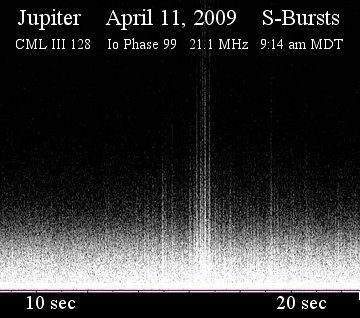
The staccato pops sound like lightning in
the loudspeaker of a car radio, but
lightning did not make these sounds.
S-bursts are caused by natural radio
lasers in Jupiter's magnetosphere that
sweep past Earth as Jupiter rotates.
> by ham radio antennas
on Earth. Jovian S-bursts and L-bursts can
mimic the sounds of woodpeckers, whales,
and waves crashing on the beach. Here are
a few audio samples:
S-bursts,
S-bursts (slowed down 128:1),
L-Bursts "I recorded the storm in
broad daylight," notes Ashcraft. "One of
the advantages of this long solar minimum
is that the daytime ionosphere is quieter
and more transparent to decametric radio
waves. There will definitely be
more good Jupiter storms in the months
to come." Stay tuned!
|
|
4-12-09 - No sunspots today
Current conditions
Solar wind
speed: 492.2 km/sec
density: 1.7 protons/cm3
explanation |
more
data
Updated: Today at 0946
UT
X-ray Solar Flares
6-hr max: A0 0940
UT Apr12
24-hr: A0 |
more data
Updated: Today at: 0940
UT
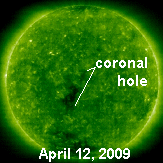
A solar wind stream flowing
from the indicated coronal hole could reach Earth on April 15th or
16th. Credit: SOHO Extreme UV Telescope
RADIO STORM ON
JUPITER: Jupiter has radio storms and
yesterday Thomas Ashcraft of New Mexico heard one. The loudspeaker
of his 21 MHz amateur radio telescope popped and crackled loudly
as natural radio lasers in Jupiter's magnetosphere swept their
beams past Earth in rapid-fire succession. Electrical currents
flowing between Jupiter's upper atmosphere and the volcanic moon
Io can boost these emissions to power levels easily detected by
ham radio antennas on Earth. Click
here and
here to listen
SOLAR
ACTIVITY: "Solar minimum? No
problem," reports Marco Vidovic of Stojnci, Slovenia.
"Lately, every time I point my telescope at the edge of
the sun, I see plenty of activity." He took this picture
on April 10th:
CORONAL MASS EJECTION:
In addition to the many prominences on
display around the sun today (see below), another form of
solar activity has appeared. The Solar and Heliospheric
Observatory is tracking a massive coronal mass ejection
(CME) billowing away from the sun's western limb:
movie. The slow-moving cloud will not hit Earth.
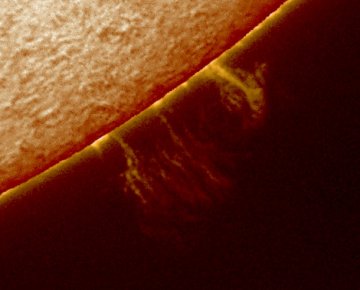
Vidovic uses a telescope equipped
with an H-alpha filter tuned to the red glow of
solar hydrogen. H-alpha filters are ideal for
catching prominences--towering plumes of hydrogen
held aloft by the sun's magnetic field. Because
prominences are not rooted in sunspots, they do
not vanish when the sunspot count plunges to zero.
Far from zero, the prominence
count today is
seven. Readers, if you have an
H-alpha telescope, take a look at the solar
activity that won't go away.
more images:
from Alan Friedman of Buffalo, New York;
from Ingmar Glass of Weißenfeld, Bavaria,
Germany;
from Steve Wainwright of Swansea UK;
from Michael Borman of Evansville, Indiana;
from Ali and John Stetson of South Portland,
Maine;
from Cai-Uso Wohler of Bispingen, Germany;
from Matthias Juergens of Gnevsdorf, Germany;
from Stephen Ames of Hodgenville, Kentucky;
|
4-11-09 - No sunspots today
Current conditions
Solar wind
speed: 552.7 km/sec
density: 1.8 protons/cm3
explanation |
more data
Updated: Today
at 2345 UT
X-ray Solar Flares
6-hr max: A0
2340 UT Apr11
24-hr: A0
0920 UT Apr11
explanation |
more data
Updated: Today
at: 2340 UT
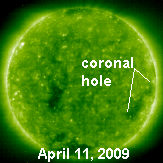
Earth is inside
a solar wind stream flowing from the indicated
coronal hole. Credit: SOHO Extreme UV Telescope
|
4-10-09 - No sunspots today
Current conditions
Solar wind
speed: 522.6 km/sec
density: 1.7 protons/cm3
explanation |
more data
Updated: Today
at 2343 UT
X-ray Solar Flares
6-hr max: A0
2340 UT Apr10
24-hr: A0
1130 UT Apr10
explanation |
more data
Updated: Today
at: 2340 UT
STEREO Hunts for Remains of an Ancient Planet
near Earth |
|
April 9, 2009: NASA's twin STEREO probes are
entering a mysterious region of space to look for remains of an
ancient planet which once orbited the Sun not far from Earth. If
they find anything, it could solve a major puzzle--the origin of
the Moon.
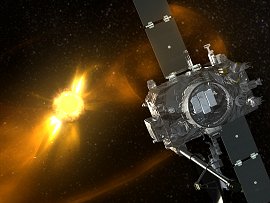 "The
name of the planet is Theia," says Mike Kaiser, STEREO project
scientist at the Goddard Space Flight Center. "It's a
hypothetical world. We've never actually seen it, but some
researchers believe it existed 4.5 billion years ago—and that it
collided with Earth to form the Moon." "The
name of the planet is Theia," says Mike Kaiser, STEREO project
scientist at the Goddard Space Flight Center. "It's a
hypothetical world. We've never actually seen it, but some
researchers believe it existed 4.5 billion years ago—and that it
collided with Earth to form the Moon."
Right: An artist's concept of one of the STEREO
spacecraft. [Larger
image]
The "Theia hypothesis" is a brainchild of Princeton theorists
Edward Belbruno and Richard Gott. It starts with the popular
Great Impact theory of the Moon's origin. Many astronomers hold
that in the formative years of the solar system, a Mars-sized
protoplanet crashed into Earth. Debris from the collision, a
mixture of material from both bodies, spun out into Earth orbit
and coalesced into the Moon. This scenario explains many aspects
of lunar geology including the size of the Moon's core and the
density and isotopic composition of moon rocks.
It's
a good theory, but it leaves one awkward question unanswered:
Where did the enormous protoplanet come from?
Belbruno and Gott believe it came from a Sun-Earth Lagrange
point.
Sun-Earth Lagrange points are regions of space where the pull of
the Sun and Earth combine to form a "gravitational well." The
flotsam of space tends to gather there much as water gathers at
the bottom of a well on Earth. 18th-century mathematician Josef
Lagrange proved that there are five such wells in the Sun-Earth
system: L1, L2, L3, L4 and L5 located as shown in the diagram
below.
When the solar system was young, Lagrange points were populated
mainly by planetesimals, the asteroid-sized building blocks of
planets. Belbruno and Gott suggest that in one of the Lagrange
points, L4 or L5, the planetesimals assembled themselves into
Theia, nicknamed after the mythological Greek Titan who gave
birth to the Moon goddess Selene.
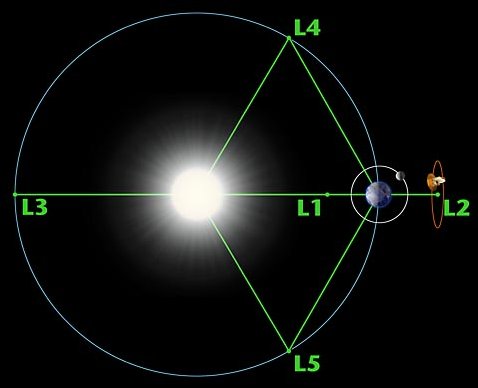
Above: Sun-Earth Lagrange points. The STEREO
probes are about to pass through L4 and L5. Solar observatories
often park themselves at L1 while deep space observatories
prefer L2. [more]
"Their computer models show that Theia could have grown large
enough to produce the Moon if it formed in the L4 or L5 regions,
where the balance of forces allowed enough material to
accumulate," says Kaiser. "Later, Theia would have been nudged
out of L4 or L5 by the increasing gravity of other developing
planets like Venus and sent on a collision course with Earth."
If this idea is correct, Theia itself is long gone, but some of
the ancient planetesimals that failed to join Theia may still be
lingering at L4 or L5.
"The STEREO probes are entering these regions of space now,"
says Kaiser. "This puts us in a good position to search for
Theia's asteroid-sized leftovers."
Just call them "Theiasteroids."
Astronomers have looked for Theiasteroids before using
telescopes on Earth, and found nothing, but their results only
rule out kilometer-sized objects. By actually entering L4 and
L5, STEREO will be able to hunt for much smaller bodies at
relatively close range.
 Right:
This dynamical simulation shows how asteroids linger in the
gravitational well of a Lagrange point of the Sun-Jupiter
system. The principle of Sun-Earth Lagrange points is the same.
Credit: Prof. Aldo Vitagliano/SOLEX. Right:
This dynamical simulation shows how asteroids linger in the
gravitational well of a Lagrange point of the Sun-Jupiter
system. The principle of Sun-Earth Lagrange points is the same.
Credit: Prof. Aldo Vitagliano/SOLEX.
"The search actually began last month when both spacecraft
rolled 180 degrees so that they could take a series of 2-hour
exposures of the general L4/L5 areas. In the first sets of
images, amateur astronomers found some known asteroids and new
comet Itagaki was imaged just a couple of days after the
announcement of its discovery. No Theiasteroids however."
Hunting for Theiasteroids is not STEREO's primary mission, he
points out. "STEREO is a solar observatory. The two probes are
flanking the sun on opposite sides to gain a 3D view of solar
activity. We just happen to be passing through the L4 and L5
Lagrange points en route. This is purely bonus science."
"We might not see anything," he continues, "but if we discover
lots of asteroids around L4 or L5, it could lead to a mission to
analyze the composition of these asteroids in detail. If that
mission discovers the asteroids have the same composition as the
Earth and Moon, it will support Belbruno and Gott's version of
the giant impact theory."
The search will continue for many months to come. Lagrange
points are not infinitesimal points in space; they are broad
regions 50 million kilometers wide. The STEREO probes are only
in the outskirts now. Closest approach to the bottoms of the
gravitational wells comes in Sept-Oct. 2009. "We have a lot of
observing ahead of us," notes Kaiser.
Readers, you may be able to help. The STEREO team is inviting
the public to participate in the search by scrutinizing photos
as they come in from the spacecraft. If you see a dot of light
moving with respect to the stars, you may have found a
Theiasteroid. Links to the data and further instructions may be
found at
sungrazer.nrl.navy.mil.
Let the hunt begin!
Author:
Dr. Tony Phillips | Credit:
Science@NASA
more information
Solar TErrestrial
RElations Observatory -- STEREO home page
Yahoo! 'STEREO Hunters' discussion group -- a nice
resource for people who would like to help find asteroids
and comets in STEREO images
STEREO Sees the Dark Side of the Sun -- (Science@NASA)
NASA's Future:
US Space Exploration Policy
|
4-9-09 - No sunspots today
Current conditions
Solar wind
speed: 471.5 km/sec
density: 1.7 protons/cm3
explanation |
more data
Updated: Today
at 2343 UT
X-ray Solar Flares
6-hr max: A0
2340 UT Apr09
24-hr: A0
0710 UT Apr09
explanation |
more data
Updated: Today
at: 2340 UT
3DEEP
MINIMUM: "When the sun is in
the pits of the deepest solar minimum in nearly 100
years, solar photographers have to get creative," says
Greg Piepol of Rockville, Maryland. "Yesterday, I
photographed the sun using a
Lunt Solar
Systems LS100 and rendered it as a 3D anaglyph." Put
on your red-blue glasses and behold the composition Piepol
calls 3Deep Minimum
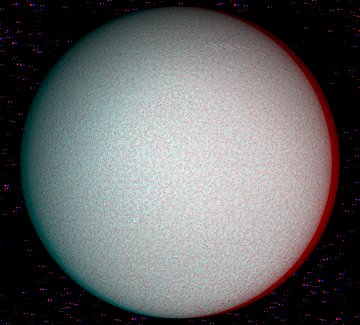
If you don't have 3D glasses, you can use
your imagination. It looks like a ball. Of
course, the sun has more relief when
sunspots are present. Browse Piepol's
3D archives to see what's missing.
SPROUTING
GRASS MOON: According to
folklore, tonight's full Moon is the "Sprouting Grass
Moon"--so-called because it shines down on the
sprouting grasses of northern Spring. Some of those
young blades are silhouetted beautifully in this photo
taken hours ago by Elias Chasiotis of Keratea, Greece:
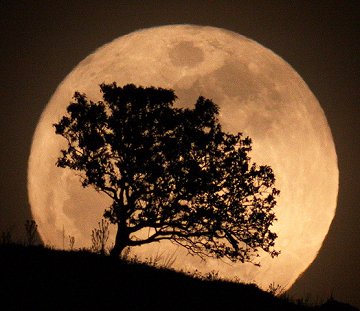
"We had a very beautiful moonrise
tonight," says Chasiotis. "The Moon was dimmed by thin
clouds, so I set my
Canon EOS 450D at ISO 400 and it worked
perfectly."
more images:
from Dennis Put of Brielle, Zuid-Holland, The
Netherlands;
from Doug Zubenel of Lenexa, Kansas;
from Abraham Tamas of Zsámbék, Hungary
COMET Yi-SWAN:
It's up all night long. Northern circumpolar Comet
Yi-SWAN is gliding through the constellation Cassiopeia where it can
be seen at almost any hour of the night through
amateur telescopes.
Working at his backyard observatory in Ellisville, Missouri, Gregg
Ruppel took this picture on April 9th:
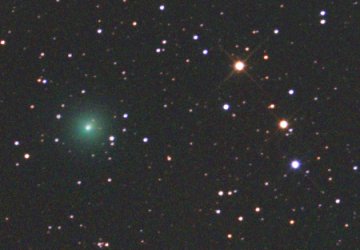
At the moment, the green, fuzzy comet
is about as bright as an 8th-magnitude star--too dim
for the naked eye. If predictions are correct, it will
remain a telescopic comet, brightening only a little
as it approaches the sun for a 190 million kilometer
not-so-close encounter on May 8th. Astronomers will
get a better look at the comet in the evenings ahead
as the bright light of the full Moon fades.
Comet Yi-SWAN was co-discovered by
amateur astronomers Dae-am Yi in Korea and Rob Matson
in the USA. Yi photographed the comet himself using a
Canon 5D and a 90 mm lens. Matson noticed it in
images taken by the Solar and Heliospheric
Observatory's
SWAN sensor. Because of naming traditions (which
should probably be modified) the comet bears SWAN's
name, not Matson's.
This appears to be Comet Yi-SWAN's
first visit to the inner solar system. A fresh comet
exposed to intense sunlight for the first time can
behave in unexpected ways. Will it grow a tail,
fragment, brighten ... ? Stay tuned for updates.
related links:
3D orbit,
ephemeris
UPDATED:
April 2009 Aurora Gallery
[previous Aprils:
2008,
2007,
2006,
2005,
2004,
2003,
2002] |
| |
4-8-09 - No sunspots today
Current conditions
Solar wind
speed: 352.8 km/sec
density: 1.1 protons/cm3
explanation |
more
data
Updated: Today at 0255
UT
X-ray Solar Flares
6-hr max: A0 2355
UT Apr07
24-hr: A0 2355 UT
Apr07
explanation |
more data
Updated: Today at: 2355
UT
|
4-7-09 - No sunspots today
Current conditions
Solar wind
speed: 362.5 km/sec
density: 0.8 protons/cm3
explanation |
more data
Updated: Today
at 2345 UT
X-ray Solar Flares
6-hr max: A0
2340 UT Apr07
24-hr: A0
2340 UT Apr07
explanation |
more data
Updated: Today
at: 2340 UT
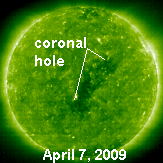
A solar wind stream flowing from
the indicated coronal hole should
reach Earth on April 9th or 10th.
Credit: SOHO Extreme UV Telescope
|
4-6-09 - No sunspots today
Current conditions
Solar wind
speed: 371.7 km/sec
density: 1.0 protons/cm3
explanation |
more data
Updated: Today
at 2345 UT
X-ray Solar Flares
6-hr max: A0
2340 UT Apr06
24-hr: A0
2340 UT Apr06
explanation |
more data
Updated: Today
at: 2340 UT
SOLAR ACTIVITY:
No sunspots? No problem. Even without
those planet-sized islands of explosive
magnetism, the sun is putting on a nice
show:
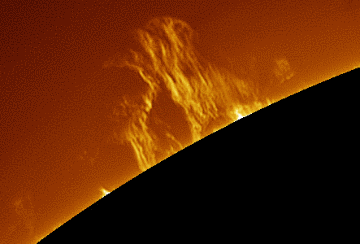
This
polar crown prominence,
a towering wall of plasma
about 50,000 km high, was
photographed yesterday by
Jerome Grenier using a
backyard solar telescope
in Paris, France.
Grenier's half-hour movie
shows a phenomenon
sometimes called "plasma
falls." Narrow streams of
plasma at the top of the
prominence are constantly
falling back to the
bottom. Mysteriously, the
streams plummet faster
than ambient magnetic
forces seem to allow.
Nuclear engineers would
like to figure out how
this happens, because it
also happens on a smaller
scale in fusion reactors
on Earth, frustrating
their efforts to sustain
an energy-producing
reaction. Maybe
prominences hold the key
to the problem.
Or
maybe they're just fun to
watch. Readers, if you
have a
solar telescope, point
it at the limb of the sun
and enjoy the show.
more images:
from James Kevin Ty of
Manila, the Philippines;
from N. Ferrin, J. Harmon
and John Stetson of
South Portland, Maine;
from Eric Roel of
Orion Observatory, Rancho
La Compañía, México;
from Greg Piepol of
Rockville, Maryland;
from Steve Rismiller
of Milford, Ohio;
from Stefano Sello of
Pisa -Italy;
|
4-5-09 - No sunspots today -
NEW: Spotless Days
Current Stretch: 9 days* 2009 total: 81 days (87%)
Since 2004: 592 days
Typical Solar Min: 485 days
explanation |
more info
Updated 04 Apr 2009
*NOTE: Updated sunspot counts by the
Solar Influences Data Center in Belgium reveal a small, previously
unnumbered sunspot on March 26th. This reduces the current stretch of
blank suns to 9.
Solar wind
speed: 307.6 km/sec
density: 1.2 protons/cm3
explanation |
more
data
Updated: Today at 0305
UT
X-ray Solar Flares
6-hr max: A0 2355
UT Apr04
24-hr: A0 2355 UT
Apr04
explanation |
more data
Updated: Today at: 2355
UT
BLANK SUN: The face of the sun is so blank, renowned sun-photographer
Greg Piepol no longer bothers to show it in his photos.
Even with the surface blanked out, however, there is still
something to see:
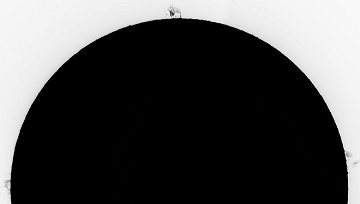
Thank goodness for prominences!"
says Piepol who took the picture on April 3rd from
his backyard observatory in Rockville, Maryland.
"They are one form of solar activity that seems to
continue even during a
Deep Solar Minimum."
It's true, clouds of hydrogen
dance along the solar limb throughout the 11-year
solar cycle. Yesterday, Piepol counted
three, and today there are
four. The "prominence number" is much larger
than the sunspot number, giving solar astronomers
reason to keep looking at the sun.
"To photograph the prominences, I
used a brand new type of H-alpha scope, the
LS100THa from
Lunt
Solar Systems," adds Piepol. "These images are
the very first light through the scope."
more images:
from Eric Roel of Orion Observatory, Rancho La
Compañía, México;
from Steve Rismiller of Milford, Ohio;
from Guenter Kleinschuster of Feldbach,
Styria, Austria
|
4-4-09 - No sunspots today
Current conditions
Solar wind
speed: 300.1 km/sec
density: 0.7 protons/cm3
explanation |
more data
Updated: Today
at 2343 UT
X-ray Solar Flares
6-hr max: A0
2340 UT Apr04
24-hr: A0
2340 UT Apr04
explanation |
more data
Updated: Today
at: 2340 UT
Plume of Sulfur Dioxide floating above the ocean
SULFUR DIOXIDE LOOP:
A loop of sulfur dioxide gas approximately 600 miles in diameter is
swirling off the coast of California. It came from Alaska where Mt.
Redoubt unleashed its biggest eruption yet on April 4th. Click on the
link to launch a 4-day animation of the volcano's SO2
emissions
http://www.spaceweather.com/swpod2009/07apr09/gome2_so2_anim_big.gif?PHPSESSID=a8k7lo726sen3ingl9da1kth57
April 4th eruption produced a long plume of stratospheric SO2
which has since split. Half is drifting across the northern
reaches of Canada; the other half is having a close encounter
with the Pacific coast of North America.
Sulfur dioxide and associated aerosols have been known to
produce sunsets of exceptional beauty. Examples from the 2008
eruption of Kasatochi may be found
here and
here. Readers in the path of Redoubt's clouds should be
alert for rare colors and rays in the evening sky.
|
|
4-3-09 - No sunspots today
Current conditions
Solar wind
speed: 266.6 km/sec
density: 0.2 protons/cm3
explanation |
more data
Updated: Today
at 2343 UT
X-ray Solar Flares
6-hr max: A0
2340 UT Apr03
24-hr: A0
0915 UT Apr03
explanation |
more data
Updated: Today
at: 2340 UT
|
|
4-2-09 - No sunspots today
Current conditions
Solar wind
speed: 306.2 km/sec
density: 2.7 protons/cm3
explanation |
more data
Updated: Today
at 2346 UT
X-ray Solar Flares
6-hr max: A0
2340 UT Apr02
24-hr: A0
2340 UT Apr02
explanation |
more data
Updated: Today
at: 2340 UT
DEEP SOLAR MINIMUM:
How low can it go?
According to NASA, the sun is plunging
into the deepest solar minimum in a
century. A new
spotless days counter on
spaceweather.com is keeping track of the
record-setting quiet.
Look for it beneath the Daily Sun.
|
|
April 1, 2009: The sunspot cycle is behaving
a little like the stock market. Just when you think it has hit
bottom, it goes even lower.
2008 was a bear. There were no sunspots observed on 266 of the
year's 366 days (73%). To find a year with more blank suns,
you have to go all the way back to 1913, which had 311
spotless days:
plot. Prompted by these numbers, some observers suggested
that the solar cycle had hit bottom in 2008.
Maybe not. Sunspot counts for 2009 have dropped even lower. As
of March 31st, there were no sunspots on 78 of the year's 90
days (87%).
It
adds up to one inescapable conclusion: "We're experiencing a
very deep solar minimum," says solar physicist Dean Pesnell of
the Goddard Space Flight Center.
"This is the quietest sun we've seen in almost a century,"
agrees sunspot expert David Hathaway of the Marshall Space
Flight Center.

Above: The sunspot cycle from 1995 to the
present. The jagged curve traces actual sunspot counts. Smooth
curves are fits to the data and one forecaster's predictions
of future activity. Credit: David Hathaway, NASA/MSFC. [more]
Quiet suns come along every 11 years or so. It's a natural
part of the sunspot cycle, discovered by German astronomer
Heinrich Schwabe in the mid-1800s. Sunspots are planet-sized
islands of magnetism on the surface of the sun; they are
sources of solar flares, coronal mass ejections and intense UV
radiation. Plotting sunspot counts, Schwabe saw that peaks of
solar activity were always followed by valleys of relative
calm—a clockwork pattern that has held true for more than 200
years:
plot.
The current solar minimum is part of that pattern. In fact,
it's right on time. "We're due for a bit of quiet—and here it
is," says Pesnell.
But is it supposed to be this quiet? In 2008, the sun
set the following records:
A 50-year low in solar wind pressure:
Measurements by the Ulysses spacecraft reveal a 20% drop in
solar wind pressure since the mid-1990s—the lowest point since
such measurements began in the 1960s. The solar wind helps
keep galactic cosmic rays out of the inner solar system. With
the solar wind flagging, more cosmic rays are permitted to
enter, resulting in increased health hazards for astronauts.
Weaker solar wind also means fewer geomagnetic storms and
auroras on Earth.
A 12-year low in solar "irradiance":
Careful
measurements by several NASA spacecraft show that the sun's
brightness has dropped by 0.02% at visible wavelengths and 6%
at extreme UV wavelengths since the solar minimum of 1996. The
changes so far are not enough to reverse the course of global
warming, but there are some other significant side-effects:
Earth's upper atmosphere is heated less by the sun and it is
therefore less "puffed up." Satellites in low Earth orbit
experience less atmospheric drag, extending their operational
lifetimes. Unfortunately, space junk also remains longer in
Earth orbit, increasing hazards to spacecraft and satellites.

Above: Space-age measurements of the total
solar irradiance (brightness summed across all wavelengths).
This plot, which comes from researcher C. Fröhlich, was shown
by Dean Pesnell at the Fall 2008 AGU meeting during a lecture
entitled "What is Solar Minimum and Why Should We Care?"
A 55-year low in solar radio emissions: After
World War II, astronomers began keeping records of the sun's
brightness at radio wavelengths. Records of 10.7 cm flux
extend back all the way to the early 1950s. Radio telescopes
are now recording the dimmest "radio sun" since 1955:
plot. Some researchers believe that the lessening of radio
emissions is an indication of weakness in the sun's global
magnetic field. No one is certain, however, because the source
of these long-monitored radio emissions is not fully
understood.
All these lows have sparked a debate about whether the ongoing
minimum is "weird", "extreme" or just an overdue "market
correction" following a string of unusually intense solar
maxima.
"Since the Space Age began in the 1950s, solar activity has
been generally high," notes Hathaway. "Five of the ten most
intense solar cycles on record have occurred in the last 50
years. We're just not used to this kind of deep calm."
Deep calm was fairly common a hundred years ago. The solar
minima of 1901 and 1913, for instance, were even longer than
the one we're experiencing now. To match those minima in terms
of depth and longevity, the current minimum will have to last
at least another year.
In
a way, the calm is exciting, says Pesnell. "For the first time
in history, we're getting to see what a deep solar minimum is
really like." A fleet of spacecraft including the Solar and
Heliospheric Observatory (SOHO), the twin STEREO probes, the
five THEMIS probes, Hinode, ACE, Wind, TRACE, AIM, TIMED,
Geotail and others are studying the sun and its effects on
Earth 24/7 using technology that didn't exist 100 years ago.
Their measurements of solar wind, cosmic rays, irradiance and
magnetic fields show that solar minimum is much more
interesting and profound than anyone expected.
NASA's Solar Dynamics Observatory. Bristling with advanced
sensors, "SDO" is slated to launch later this year--perfect
timing to study the ongoing solar minimum. [more]
Modern technology cannot, however, predict what comes next.
Competing models by dozens of top solar physicists disagree,
sometimes sharply, on when this solar minimum will end and how
big the next solar maximum will be. Pesnell has surveyed the
scientific literature and prepared a "piano
plot" showing the range of predictions. The great
uncertainty stems from one simple fact: No one fully
understands the underlying physics of the sunspot cycle.
Pesnell believes sunspot counts will pick up again soon,
"possibly by the end of the year," to be followed by a solar
maximum of below-average intensity in 2012 or 2013.
But like other forecasters, he knows he could be wrong. Bull
or bear? Stay tuned for updates.
|
| 4-1-09 - No sunspots today
Solar wind
speed: 358.4 km/sec
density: 2.1 protons/cm3
explanation |
more data
Updated: Today at 1915 UT
X-ray Solar Flares
6-hr max: A0 1915 UT
Apr01
24-hr: A0 0610 UT
Apr01
explanation |
more data
Updated: Today at: 1915 UT
NO SUNSPOTS:
As April begins, the sun has been spotless for 24 consecutive days.
How long can the blank spell continue? The longest stretch of blank
suns in the past 100 years was 92 days in April, May and June of 1913.
To match that streak, today's sun must remain spotless until early
June 2009. That's a lot of quiet; stay tuned |
